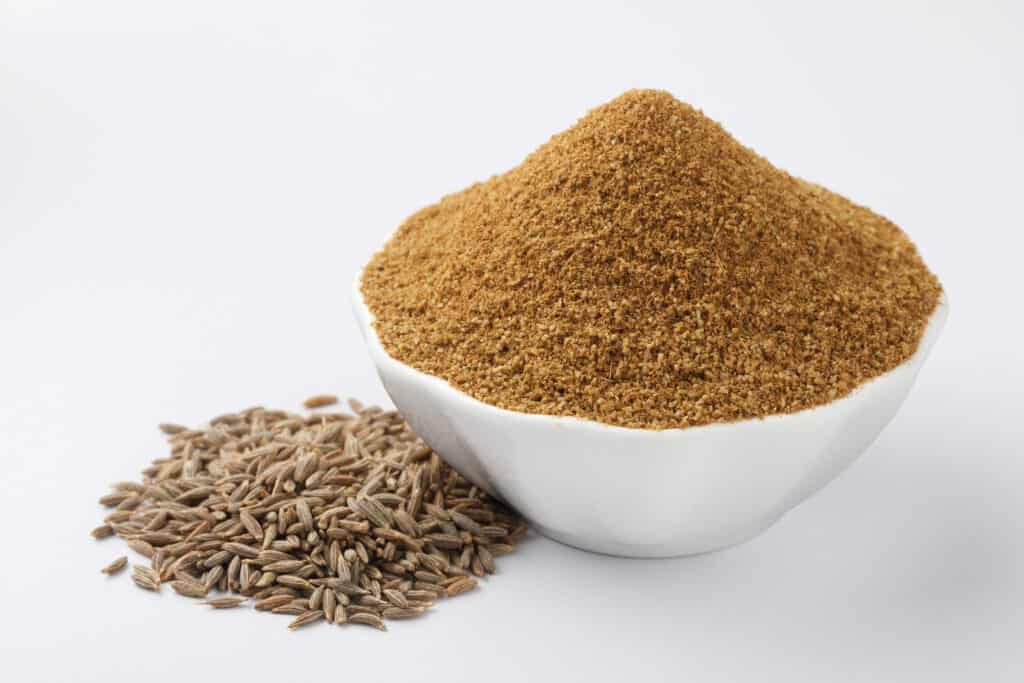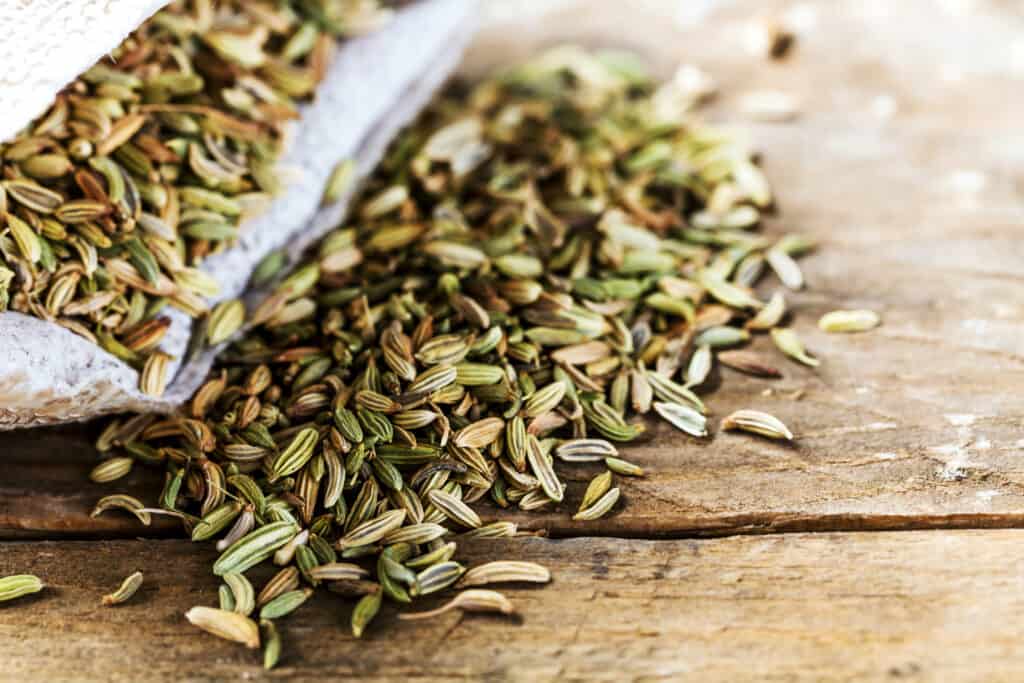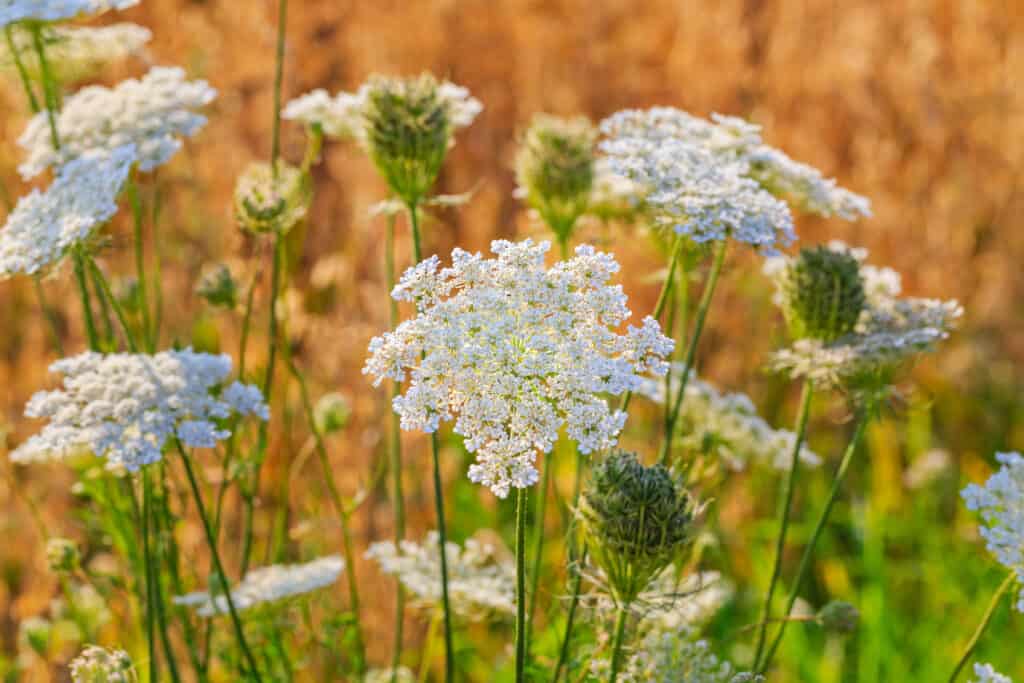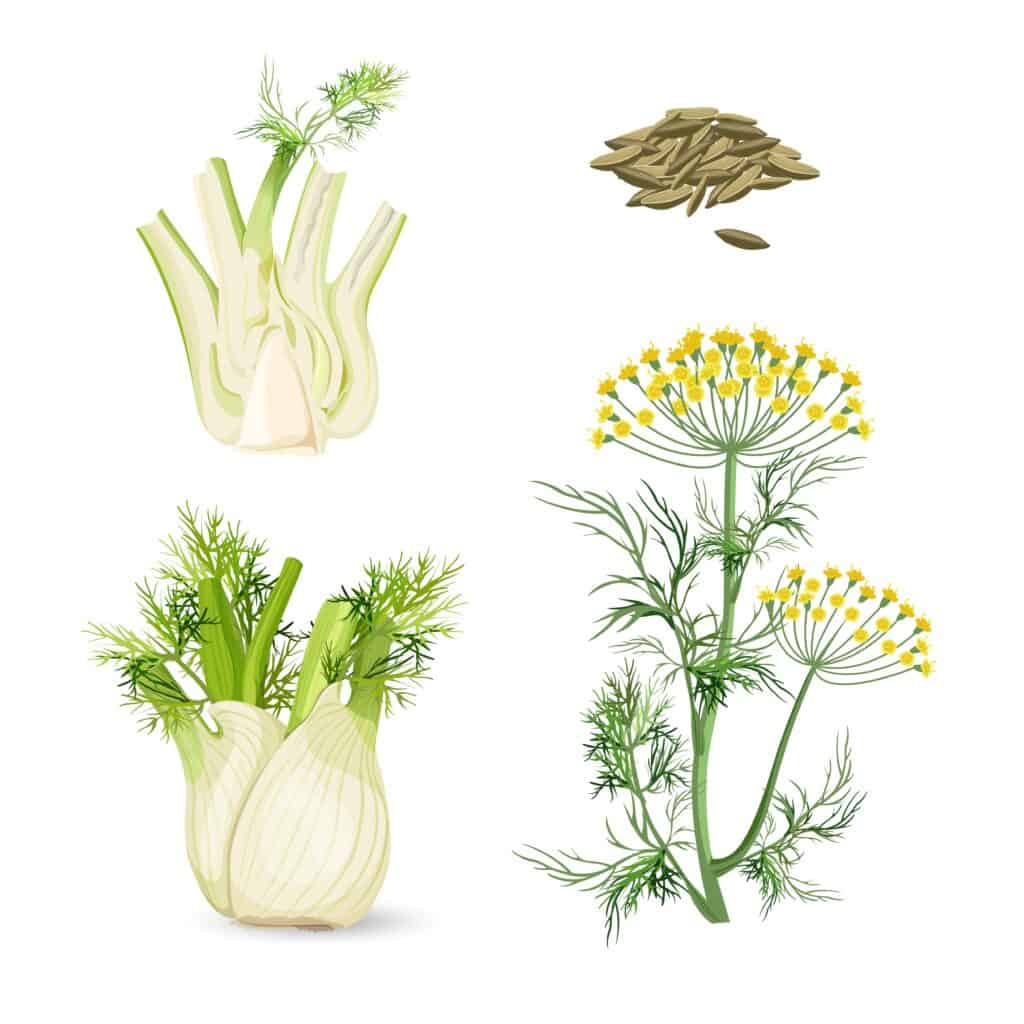Cumin and fennel seeds are often confused with each other because they are both tiny oblong brown seeds. But if you taste them, they are easy to tell apart. Another significant difference is in the plant itself; they don’t look much alike in comparison. There are also differences in climate and growth requirements as well as size. We will discuss the similarities and differences in more detail below.
Comparing Cumin vs. Fennel

cumin powder and cumin seeds. Selective focus
©asmiphotoshop/Shutterstock.com
| Cumin | Fennel | |
|---|---|---|
| Scientific Family | Apiaceae family | Apiaceae family |
| Native Region | Native to Irano-Turanian region | Native to the shores of the Mediterranean |
| Uses | Whole and ground seeds are used as a culinary herb | Whole and ground seed is used as a culinary spice. The bulb, stalk, and leaves are edible. The plant is used to make alcohol. Often planted as an ornamental for its tall fern-like foliage |
| Height of plant | Twelve to twenty inches tall | Four to eight feet tall |
| Flower Description | White or pink with umbels | Yellow with umbels |
| Leaf Description | Gray or dark green pinnate leaves that are 2-4″ long | Blueish green leaves that are 16″ long and finely dissected and feathery in appearance |
| Soil Requirements | Fertile, sandy, loamy soil with good drainage. A drought tolerant. 8+ hours of sun per day | Fertile, sandy, loamy soil with excellent drainage. 6-8 hours of sun per day. Drought tolerant |
| Temperature Requirements | Loves heat. Requires temperatures between 77-86°F for three or four months. | Hardy in USDA Zones 4-9. Winter temperatures as low as -20°F |
| Taste | Earthy, warm, aromatic | Anise or licorice |
| Propagation | From seed | From seed or root crown |
Key Differences Between Cumin vs. Fennel
The key differences between cumin vs. fennel are climate requirements, tastes, and flowers. Other differences include propagation, growth heights, and uses. Let’s explore some of these differences more deeply.
Cumin vs. Fennel: Native Region

Fennel is native to the shores of the Meditteranean but has spread to many parts of Europe, Canada, Asia, Australia, and the United States.
©HUIZENG/Shutterstock.com
Cumin is native to the Irano-Turanian region. This area receives most of its precipitation in the winter and spring, so plants that grow in the hot summer need to be sun-loving and drought-tolerant.
Fennel is native to the shores of the Meditteranean but has spread to many parts of Europe, Canada, Asia, Australia, and the United States. It is so prolific in Australia that they consider fennel an invasive weed. Fennel prefers a dry coastal area to call home.
Cumin vs. Fennel: Uses
Cumin is used exclusively as a culinary herb. Cooks use whole and ground seeds to flavor soups, curries, tacos, and meats worldwide. Once upon a time, cumin was used in traditional medicine and as an essential oil.
Cooks use fennel in a variety of ways. They use the seeds to impart a licorice flavor to many types of food. Many people eat the bulb and hollow stem as edible vegetables. The whole plant is used in Switzerland to make absinthe, a kind of alcohol. And finally, fennel is grown for its beautiful feathery foliage and left in the garden for winter interest. The flowers are highly attractive to bees and butterflies and make an excellent addition to a pollinator garden.
Cumin vs. Fennel: Taste

Cumin is one of the main ingredients in taco seasoning and curry spice mixes.
©nnattalli/Shutterstock.com
Cumin has a warm earthy taste with a slightly bitter edge. Cooks use this herb to provide a depth of flavor. It is one of the main ingredients in taco seasoning and curry spice mixes. It pairs well with meat, sauces, and vegetables equally.
Fennel has distinct licorice or anise flavoring. When cooked, it gets sweeter. Cooks use the seed to provide a sweet flavor to stews, slaws, and rice dishes. The chopped stems and bulb add a celery-like crunch to salads and soups.
Cumin vs. Fennel: Appearance
Cumin is an annual herbaceous plant that thrives in a tropical or subtropical region. It has slender branches and stems and dark green or gray leaves. The leaves are two to four inches long, ending in white or pink flowers. The flowers are umbel shaped and uniform in size. The fruits are called achene, and each bears one seed. The seeds are 1/6″ long and have a yellow-brown color.
Fennel is a hardy perennial herb. It also has umbel-shaped flowers, but they are bright yellow. The feathery leaves look similar to dill. It grows four to eight feet high and has hollow stems. The leaves are up to 16 inches long and finely dissected. The fruit is called a schizocarp and is 3/8″ long.
Cumin vs. Fennel: Growing Requirements

Fennel is hardier than cumin and can withstand a colder environment.
©iStock.com/Godruma
Cumin needs heat. It comes from a hot, dry climate and requires a summer temperature between 77-86°F for three to four months to thrive. Plant in fertile, sandy, loamy soil that has good drainage. Water seldomly, but deeply.
Fennel is hardier than cumin and can withstand a colder environment. It does still need six or more hours of sun per day. It prefers sandy, fertile soil with excellent drainage. Remember that it is native to coastal areas and grows in sand dunes. Water fennel infrequently but deeply. Leave the stalks over winter for visual interest, or cut them down in the fall.
Cumin vs. Fennel: Propagation
Cumin and fennel are both easy to propagate. If allowed to flower and go to seed, these herbs will provide you with hundreds of seeds per plant. The easiest method to catch the seeds is to place a brown paper bag over the flower head and shake it. All of the seeds will fall into the bag for safekeeping. You can also propagate fennel from the root crown by placing it in a bowl of water to grow roots.
NEXT UP…
- 19 Vegetables to Plant in September
- The 12 Best Perennial Herbs That Come Back Every Year
- The Best Deer Fence To Protect Your Garden
The photo featured at the top of this post is ©
Thank you for reading! Have some feedback for us? Contact the AZ Animals editorial team.






